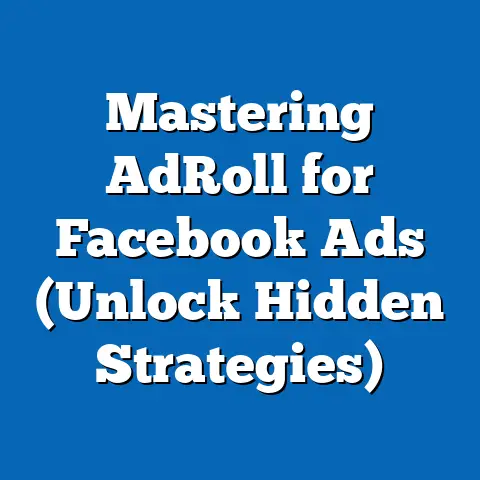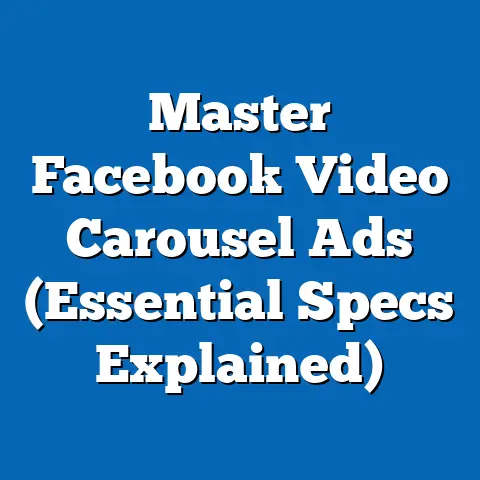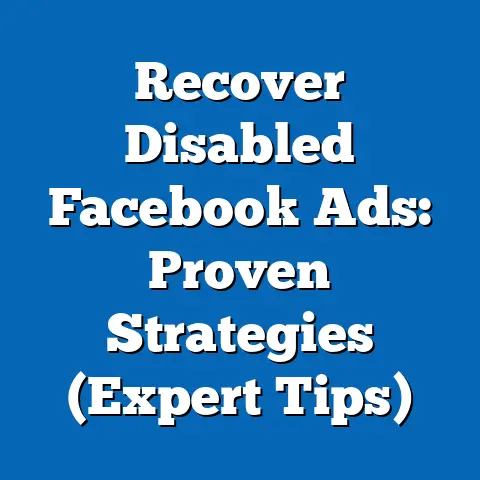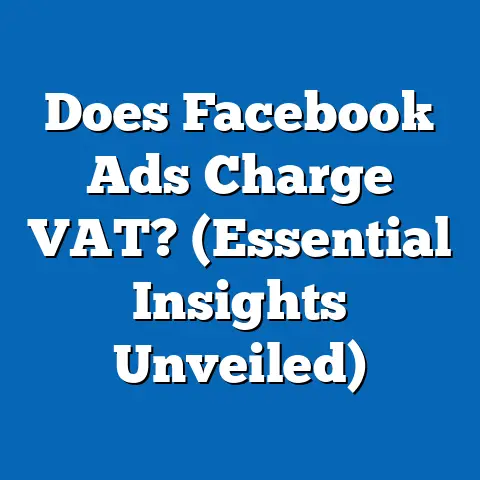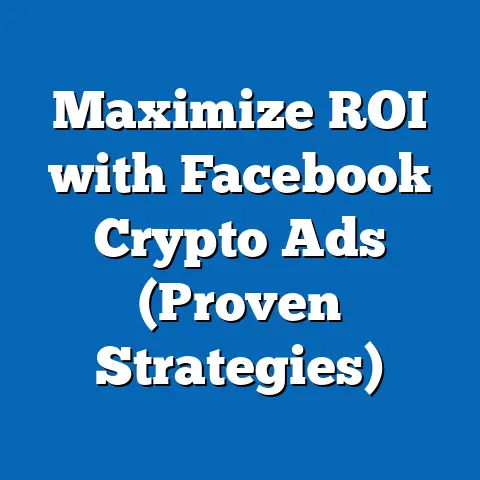Unlock Profits from Facebook Ads (Game-Changing Strategies)
In today’s fiercely competitive digital arena, businesses can no longer afford to view advertising as a mere expense. Instead, it’s time to embrace a paradigm shift and recognize advertising, especially on platforms like Facebook, as a strategic investment poised to deliver substantial returns. Think of it this way: you’re not just spending money; you’re planting seeds for future growth.
The proof is in the pudding: Studies consistently show that businesses can achieve an impressive ROI on Facebook advertising. In fact, some reports suggest an average return of $8 for every $1 spent! That’s not just pocket change; it’s a game-changer. These remarkable figures underscore the immense potential that well-executed Facebook campaigns hold for businesses of all sizes. As someone who’s spent years navigating the ever-evolving landscape of digital marketing, I’ve personally witnessed how a strategic approach to Facebook ads can transform a struggling business into a thriving success story. This guide is your roadmap to unlocking those profits.
Section 1: Understanding the Facebook Advertising Ecosystem
Facebook ads are paid messages that businesses use to reach specific audiences on the Facebook platform. Their primary purpose is to promote products, services, or ideas, ultimately driving desired actions from users. These actions can range from increasing brand awareness to generating leads, driving website traffic, or boosting sales.
One of the reasons I love Facebook advertising is the sheer variety of ad formats available. It’s like having a toolbox filled with different instruments to tackle diverse marketing challenges. Here’s a quick rundown:
- Image Ads: The simplest format, featuring a single image and accompanying text. Ideal for showcasing products or conveying a clear message.
- Video Ads: Capture attention with moving visuals. They’re fantastic for storytelling, demonstrating product features, or creating engaging brand content.
- Carousel Ads: Display multiple images or videos in a scrollable format, perfect for showcasing a range of products or highlighting different aspects of a single offering.
- Collection Ads: Designed for e-commerce, these ads feature a main image or video with related product images displayed below, creating a seamless shopping experience.
- Instant Experience Ads: Formerly known as Canvas ads, these full-screen, mobile-optimized ads offer an immersive experience, allowing users to interact with your brand in a dynamic way.
But the real magic of Facebook advertising lies in its unparalleled targeting capabilities. Facebook allows you to pinpoint your ideal audience with laser-like precision, ensuring that your ads are seen by the people most likely to be interested in your products or services. This is where the “investment” aspect truly shines through.
You can segment your audience based on a wide range of factors:
- Demographics: Age, gender, location, education level, and more.
- Interests: Hobbies, passions, and interests based on the pages they like and the content they engage with.
- Behaviors: Past purchasing behavior, online activity, and device usage.
- Custom Audiences: Upload your existing customer lists or website visitor data to target people who have already interacted with your business.
- Lookalike Audiences: Expand your reach by targeting people who share similar characteristics with your existing customers. This is one of my personal favorite strategies for scaling campaigns.
By leveraging these targeting options, you can ensure that your ad dollars are spent wisely, reaching the right people at the right time.
Takeaway: Facebook advertising offers a diverse range of ad formats and powerful targeting options, making it a versatile platform for achieving various marketing objectives.
Section 2: Setting Clear Objectives
Before you even think about creating your first ad, it’s crucial to define your objectives. What do you want to achieve with your Facebook advertising campaign? Are you looking to increase brand awareness, generate leads, drive website traffic, or boost sales?
Setting clear, measurable objectives is the cornerstone of a successful campaign. Without a clear goal in mind, you’ll be wandering aimlessly, wasting time and money. Think of it like embarking on a road trip without a destination – you might enjoy the scenery, but you’re unlikely to reach your intended destination.
Different objectives require different strategies. For example, if your goal is brand awareness, you’ll focus on reaching a broad audience with engaging content that showcases your brand’s personality and values. On the other hand, if your goal is lead generation, you’ll create ads that encourage users to provide their contact information in exchange for a valuable offer, such as a free ebook or a consultation.
To ensure that your objectives are effective, I always recommend using the SMART framework:
- Specific: Clearly define what you want to achieve. For instance, instead of saying “increase sales,” say “increase sales of product X by 20%.”
- Measurable: Establish how you’ll track your progress. For example, track website traffic, lead generation, or conversion rates.
- Achievable: Set realistic goals that are within your reach. Don’t aim for the moon if you’re just starting out.
- Relevant: Ensure that your goals align with your overall business objectives.
- Time-bound: Set a deadline for achieving your goals. For example, “increase sales of product X by 20% in the next three months.”
Here are a few examples of SMART goals for Facebook advertising:
- Brand Awareness: “Increase brand reach by 15% among women aged 25-34 in the next month.”
- Lead Generation: “Generate 50 qualified leads per week through a lead magnet offering a free consultation.”
- Conversions: “Increase online sales of product Y by 10% in the next quarter.”
By setting SMART goals, you’ll have a clear roadmap to follow, making it easier to track your progress and optimize your campaigns for success.
Takeaway: Defining clear, measurable objectives using the SMART framework is essential for creating effective Facebook advertising campaigns.
Section 3: Crafting Compelling Ad Creatives
The visual and textual elements of your Facebook ads are your first impression on potential customers. If your ad creatives are bland, uninspired, or irrelevant, you’ll quickly lose their attention. On the other hand, if your ad creatives are compelling, engaging, and relevant, you’ll capture their interest and entice them to take action.
Here’s what I’ve learned over the years about creating high-performing ad creatives:
- Eye-Catching Visuals: Your visuals should be visually appealing, high-quality, and relevant to your target audience. Use vibrant colors, striking imagery, and consistent branding to grab attention. Think about what kind of images or videos would resonate most with your target audience and make them stop scrolling. For example, if you’re selling fitness equipment, use images of people achieving their fitness goals, not just pictures of the equipment itself.
- Strong Hook: Your headline should immediately grab the reader’s attention and pique their curiosity. Use a compelling question, a bold statement, or a surprising statistic to draw them in.
- Concise Messaging: Get straight to the point and highlight the key benefits of your product or service. Use clear, concise language that is easy to understand. Avoid jargon and technical terms that your target audience might not be familiar with.
- Emotional Appeal: Connect with your audience on an emotional level by addressing their pain points, aspirations, or desires. Show them how your product or service can solve their problems or help them achieve their goals.
- Clear Call to Action (CTA): Tell people exactly what you want them to do. Use strong action verbs like “Shop Now,” “Learn More,” “Sign Up,” or “Get Started.” Make your CTA button prominent and easy to find.
Here are a few examples of successful ad creatives from various industries:
- E-commerce: A clothing brand uses a carousel ad to showcase its latest collection, featuring high-quality images of models wearing the clothes in stylish settings. The ad copy highlights the brand’s commitment to sustainable fashion and offers a discount code for first-time buyers. The CTA button says “Shop Now.”
- Software: A SaaS company uses a video ad to demonstrate the key features of its software and how it can help businesses improve their productivity. The ad copy addresses the pain points of busy professionals and offers a free trial. The CTA button says “Get Started.”
- Local Business: A restaurant uses an image ad to promote its new menu, featuring mouthwatering photos of its signature dishes. The ad copy highlights the restaurant’s cozy atmosphere and offers a special discount for lunch customers. The CTA button says “Order Now.”
Remember, the key to creating compelling ad creatives is to understand your target audience and tailor your message to their specific needs and interests.
Takeaway: High-performing ad creatives combine eye-catching visuals, concise messaging, emotional appeal, and a clear call to action to capture attention and drive desired actions.
Section 4: Leveraging A/B Testing for Optimization
A/B testing, also known as split testing, is a powerful technique for optimizing your Facebook ad performance. It involves creating two or more versions of your ad, each with a slight variation, and then testing them against each other to see which one performs better.
The beauty of A/B testing is that it allows you to make data-driven decisions, rather than relying on guesswork. By systematically testing different elements of your ads, you can identify what resonates most with your target audience and optimize your campaigns for maximum impact.
Here’s how to set up A/B tests effectively:
- Choose an Element to Test: Focus on testing one element at a time to isolate the impact of that specific change. Common elements to test include headlines, images, ad copy, CTAs, and audience segments.
- Create Variations: Develop two or more versions of your ad, each with a slight variation in the element you’re testing. For example, you might test two different headlines or two different images.
- Set Up Your Test: Use Facebook’s built-in A/B testing tool to create your test. Define your budget, duration, and target audience.
- Monitor Your Results: Track the performance of each variation and identify the winner. Pay attention to key metrics like click-through rate (CTR), conversion rate, and cost per acquisition (CPA).
- Implement the Winner: Once you’ve identified the winning variation, implement it in your main campaign.
Here are a few examples of businesses that successfully improved their ad performance through systematic testing:
- An e-commerce store tested two different headlines for its product ads. One headline focused on the product’s features, while the other focused on its benefits. The headline that focused on benefits generated a 20% higher click-through rate.
- A SaaS company tested two different images for its lead generation ads. One image featured a product screenshot, while the other featured a customer testimonial. The customer testimonial image generated a 30% higher conversion rate.
- A local restaurant tested two different CTAs for its dinner ads. One CTA said “Order Now,” while the other said “View Menu.” The “View Menu” CTA generated a 15% higher click-through rate.
A/B testing is an ongoing process. As you gather more data and learn more about your target audience, you’ll be able to refine your testing strategies and further optimize your campaigns.
Takeaway: A/B testing allows you to make data-driven decisions, optimize your ad performance, and maximize your ROI by systematically testing different elements of your ads.
Section 5: Budgeting and Bidding Strategies
Budgeting and bidding strategies are crucial for maximizing the effectiveness of your Facebook advertising campaigns. It’s about finding the sweet spot where you’re spending enough to reach your target audience and achieve your objectives, without overspending and wasting money.
Here’s how to allocate your budget effectively:
- Start Small: Begin with a small budget and gradually increase it as you see positive results. This allows you to test different strategies and optimize your campaigns without risking a large amount of money.
- Prioritize Your Campaigns: Allocate more budget to campaigns that are performing well and less budget to campaigns that are underperforming.
- Consider Your Audience Size: The larger your target audience, the more budget you’ll need to reach them effectively.
- Factor in Your Conversion Value: If you’re running conversion-focused campaigns, allocate more budget to campaigns that are generating high-value conversions.
Facebook offers two main bidding strategies:
- Manual Bidding: You set the maximum amount you’re willing to pay for each click or impression. This gives you more control over your ad spend, but it requires more monitoring and optimization.
- Automatic Bidding: Facebook automatically sets your bids based on your budget and objectives. This is a more hands-off approach, but it can be less efficient if you’re not careful.
Here’s when to use each bidding strategy:
- Manual Bidding: Use manual bidding when you have a clear understanding of your target audience and the value of each click or impression. This is a good option for experienced advertisers who want more control over their ad spend.
- Automatic Bidding: Use automatic bidding when you’re just starting out or when you don’t have a clear understanding of your target audience. This is a good option for beginners who want to let Facebook handle the bidding process.
Regardless of which bidding strategy you choose, it’s important to monitor your ad spend regularly and adjust your bids as needed. Keep an eye on key metrics like cost per click (CPC), cost per impression (CPM), and cost per acquisition (CPA). If your costs are too high, try lowering your bids or refining your targeting.
Takeaway: Effective budgeting and bidding strategies involve allocating your budget wisely, choosing the right bidding strategy for your needs, and monitoring your ad spend regularly.
Section 6: Analyzing and Adjusting Campaigns
Analyzing your Facebook ad performance is like reading a map on a journey. It tells you where you are, where you’re going, and what adjustments you need to make to reach your destination. Without regular analysis, you’re essentially driving blind, hoping to stumble upon success.
Here are the key metrics to track for evaluating your Facebook ad performance:
- Click-Through Rate (CTR): The percentage of people who see your ad and click on it. A high CTR indicates that your ad is relevant and engaging.
- Cost Per Click (CPC): The amount you pay each time someone clicks on your ad. A low CPC indicates that you’re targeting the right audience and your ads are resonating with them.
- Conversion Rate: The percentage of people who click on your ad and then take a desired action, such as making a purchase or filling out a form. A high conversion rate indicates that your landing page is effective and your offer is compelling.
- Return on Ad Spend (ROAS): The amount of revenue you generate for every dollar you spend on advertising. A high ROAS indicates that your campaigns are profitable.
Regular analysis is crucial for making informed decisions about your campaigns. Look for patterns in the data and identify areas where you can improve. For example, if you notice that your CTR is low, try testing different headlines or images. If you notice that your conversion rate is low, try optimizing your landing page or refining your offer.
Based on your performance data, here are a few actionable steps you can take to adjust your campaigns:
- Pause Underperforming Ads: If an ad is not performing well, don’t be afraid to pause it and focus your resources on ads that are generating positive results.
- Scale Successful Ads: If an ad is performing exceptionally well, consider increasing its budget or expanding its targeting to reach a wider audience.
- Refine Your Targeting: If you’re not reaching the right people, try refining your targeting criteria. Experiment with different demographics, interests, and behaviors.
- Optimize Your Landing Page: If your conversion rate is low, make sure that your landing page is relevant to your ad and that it provides a clear and compelling offer.
Remember, Facebook advertising is an iterative process. It requires constant testing, analysis, and optimization to achieve the best possible results.
Takeaway: Regular analysis of key metrics is essential for making informed decisions, optimizing your campaigns, and maximizing your ROI.
Conclusion: The Long-term Vision for Facebook Ads
As you embark on your Facebook advertising journey, remember that it’s not a sprint, but a marathon. It’s not about achieving overnight success, but about building a sustainable, long-term strategy for brand growth and customer acquisition.
View Facebook ads as a vital investment in your business’s future. Embrace a mindset of continuous learning and adaptation, staying up-to-date with the latest trends and best practices. The Facebook advertising landscape is constantly evolving, so it’s crucial to remain agile and adaptable.
Take the first steps today. Implement the strategies discussed in this guide and start unlocking the profits that Facebook ads can deliver. The potential is there, waiting to be unleashed. Don’t let fear or uncertainty hold you back. The time to invest in your business’s future is now. Start experimenting, start testing, and start seeing the results. Your journey to Facebook advertising success starts today!


